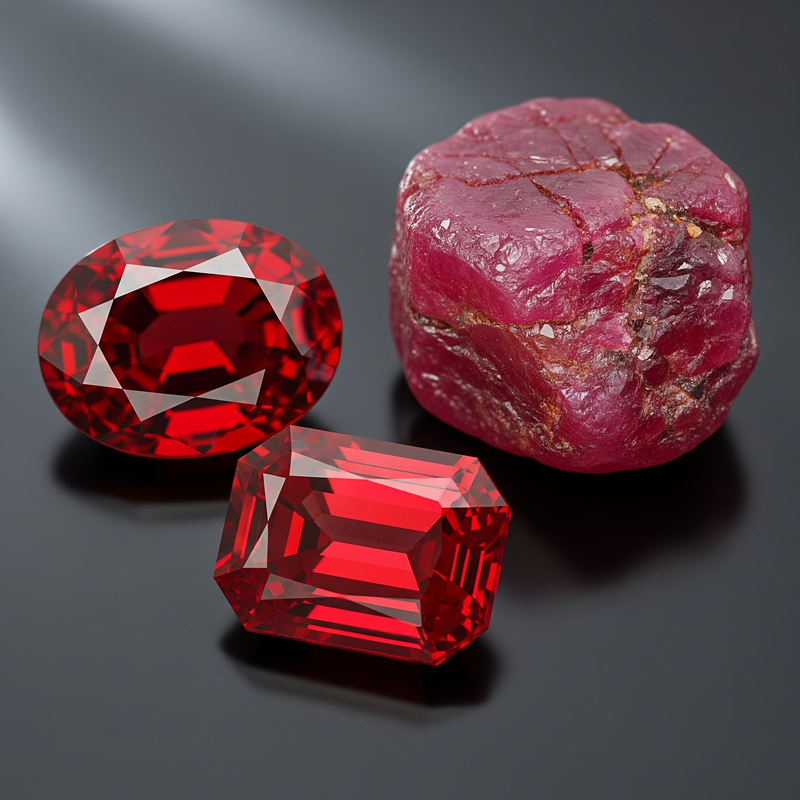
Buying ruby jewelry is an exciting and deeply personal experience. Whether you’re celebrating a July birthday, looking for a unique engagement ring, or simply adding a splash of vibrant color to your collection, understanding what makes a ruby valuable is key. Understanding the important factors to consider, from the stone’s quality to its origin, can help you make a confident and beautiful choice.
1. The Four Cs: The Cornerstone of Ruby Value
Color, Clarity, Cut, and Carat Weight, just like diamonds are the four key factors of ruby gemstone grading. While all are important, color is the single most critical factor that determines a ruby’s worth.
- Color (The King of Rubies): A ruby’s value is defined by its color. The most prized rubies have a vibrant, saturated red hue with a hint of purple. The legendary “Pigeon’s Blood” color—a vivid red with a slight purplish tinge—is the benchmark for the finest and rarest rubies in the world. Look for a stone with a rich, uniform color that is neither too dark nor too light.
- What to watch out for: A ruby that is too light or has a pinkish tone may be classified as a pink sapphire, while a stone that is too dark can appear dull.
- Clarity: A truly flawless, “eye-clean” natural ruby is exceptionally rare. Tiny internal features, known as inclusions, are common and even expected in natural rubies. These are like a gemstone’s fingerprints.
- What to look for: While some inclusions are normal, they should not be overly visible to the naked eye. Inclusions that are large or located near the top of the stone can detract from its brilliance. The presence of fine, reflective inclusions called “silk” can actually enhance a ruby’s beauty by scattering light.
- Fact: A perfectly flawless ruby is often a sign that the stone is lab-grown.
- Cut: The cut of a ruby refers to its shape (like oval, cushion, or round) and the geometric proportions that allow it to reflect light. A skilled gem cutter’s goal is to maximize the stone’s color and brilliance while minimizing the visibility of any inclusions.
- What to look for: A well-cut ruby will have excellent symmetry and an even distribution of color. Avoid stones with “windows” or dark spots where light passes straight through the gem without being reflected back.
- Carat Weight: A carat is the standard unit of measurement for a gemstone’s weight (1 carat = 0.2 grams). While a larger ruby has a higher carat weight, a smaller, high-quality ruby will almost always be more valuable than a larger, low-quality one. The ruby price per carat increases exponentially as the stone size and quality rise, due to the extreme rarity of large, fine-quality rubies.
2. Natural vs. Lab-Grown Rubies: Understanding Your Options
When you’re buying ruby jewelry, you have a choice between a natural gemstone and a lab-grown one.
- Natural Rubies: These are gemstones that formed naturally in the Earth over millions of years. Their rarity and unique character are what give them their prestige and enduring value.
- Lab-Grown Rubies: Created in a controlled laboratory environment, these rubies have the exact same chemical, physical, and optical properties as their natural counterparts. Lab-grown rubies are a more affordable and often flawless alternative.
Beyond the Four Cs
- Where Do the Best Rubies Come From? Some regions are famous for producing rubies of exceptional quality. Rubies from Myanmar (formerly Burma) are legendary for their intense “Pigeon’s Blood” color and command the highest prices. The Burmese ruby vs Mozambican ruby comparison is also common, as rubies from Mozambique are highly regarded for their vibrant color. Other notable sources include Sri Lanka, Madagascar, and Thailand.
- Treatments: The vast majority of rubies on the market today have been heat-treated to improve their color and clarity. This is a common and widely accepted industry practice. However, it is crucial that a jeweler is transparent about this. Untreated, high-quality rubies are exceedingly rare and are valued at a significant premium.
The Importance of Certification
For a high-value purchase, always ask for a gemological certification from a reputable third-party lab like the GIA (Gemological Institute of America). This certificate provides an objective report on the stone’s quality, including its color, clarity, carat weight, origin, and any treatments, giving you complete confidence in your purchase.
By following this ruby buying guide, you’re well-equipped to choose a piece of ruby jewelry that is not only beautiful but also holds its value for generations to come.